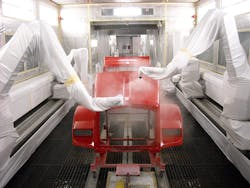Used-truck demand helping drive up new Class 8 orders
There’s now a sellers’ market in place for used Class 8 trucks that’s so strong it’s helping boost orders for new equipment, according to analyst Michael Baudendistel, vice president of the Stifel Transportation, Logistics and Equipment Research Group.
Discussions at last week’s 51st ACT Research Seminar “supported our view that the North American commercial truck, tractor, and trailer markets remain healthy and we believe those markets are in the midst of replacement cycles that should persist over multi-year periods,” advised Baudendistel in a takeaway report on the conference, whose attendees included representatives of OEMs, component suppliers and truck dealers.
“While we were already familiar with the impact that higher MPG of new tractors is having on equipment orders, before attending the conference we did not fully appreciate the positive impact that the strength in the used tractor market is also having on supporting new equipment orders,” he pointed out.
Baudendistel stated that there’s a shortage of late-model/low-mileage used tractors that has “pushed up the prices of the desirable pieces of used equipment into the $70,000 range. The high prices for used equipment are supportive of new equipment purchases as the large fleet buying new equipment need to finance less for each new power unit purchased.”
He noted that an exception to the generally high prices for late-model used equipment are “Navistar tractors with model years just after the 2010 emissions requirements; those tractors are often trading $10,000 to $12,000 below the prices of comparable equipment produced by the other manufacturers.”
What’s more, he stated that “used truck buyers are demonstrating an aversion to buying any model year 2007 equipment, which are the tractors that were first compliant with the EPA 2007 emissions standards.”
Baudendistel said one reason why there’s a shortage of low-mileage used equipment is that fleets are keeping their tractors longer. “The other reason is the relative lack of building during and shortly after the recession,” he remarked.
“Cycle times for Class 8 tractors are lengthening with the large fleets that buy new equipment trading in used equipment after 550,000 miles,” Baudendistel noted, “up from the 500,000 miles that has been more typical a few years ago.”
Even so, strong order activity has kept the backlog-to-build ratio for Class 8 OEMs “within the healthy range of four to five months,” pointed out Baudendistel. “There are few build slots for Class 8 tractors available for 2014 at this point and orders are now being booked for 1Q15. While September is historically a slow month for orders, orders typically pick back up before year end.
“In light of the strong orders this year and healthy backlogs ahead of another seasonally strong period for orders, it would not surprise us if the OEMs continued to increase production rates,” he continued, “which increased 7% to 8% sequentially in 1Q14 and 2Q14.”
Baudendistel remarked that only 13% of the orders received during 3Q were built during that quarter. He said that may reflect that orders and sizable backlogs have been widespread across OEMs. “So, for instance, Navistar may not be struggling to obtain orders as much as some have feared.”
As for light- and medium-duty equipment, he said those markets have “recovered steadily since the recession and continued moderate levels of growth is expected based on improvements in housing data and governmental tax receipts.”
Stifel also discerned less focus on natural-gas vehicles at this ACT Research conference than was the case at the past few that the firm had attended.
“The phrase used repeatedly is that natural gas in heavy duty trucking will be evolutionary rather than revolutionary,” said Baudendistel. “We believe that the greater emphasis on the improving MPG associated with diesel engines, both to meet upcoming greenhouse gas standards and to reduce operating costs, has taken some momentum away from natural gas.
“That said,” he continued, “natural gas is without question ideal for certain specialty markets, such as refuse vehicles and transit buses, and should be a growing portion of highway tractors.”
Citing a major provider of natural gas fueling systems, Baudendistel remarked that “there should be around 8,700 heavy duty tractors produced this year running on natural gas, up from 7,200 in 2013 and 5,300 in 2012. We believe greater adoption of the CWI 12L natural gas engine (the area of natural gas growth in heavy duty trucking in 2014), additional upcoming engine introductions, and the introduction of new high capacity fueling systems, including those that are placed back of the cab, will expand the market for natural gas applications in heavy duty trucking as the larger fuel systems make range less of an issue.”
Turning to the outlook for growth in the ranks of owner-operators, Baudendistel said that the investment bank views insurance requirements as a “major (and in our view unsung) factor preventing new entrants into the commercial driving profession. Insurance providers in attendance said, essentially, that they would not insure a driver on his own without [having] experience.
“Rather,” he continued, “a driver would need to complete a training school associated with one of the large fleets and complete at least a couple years of commercial driving experience before a driver could purchase insurance as an owner-operator at a reasonable rate.”
Baudendistel also advised that “ACT Research believes there is a very strong possibility of the longer 33-ft LTL pup trailers being approved in 2015… The case for believing that the larger trailers will be approved is related to the coalition of large LTL carriers that are lobbying for the longer trailers, an effort that is being spearheaded by FedEx.”
He explained that such trailers “would make the LTL carriers close to 20% more productive when the new equipment is applied to freight that cubes out. We believe that LTL carriers would purchase the equipment aggressively if the longer trailers were to be approved.”
